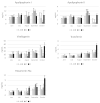Field Application of an Innovative Approach to Assess Honeybee Health and Nutritional Status
- PMID: 39123709
- PMCID: PMC11311059
- DOI: 10.3390/ani14152183
Field Application of an Innovative Approach to Assess Honeybee Health and Nutritional Status
Abstract
Environment, forage quality, management practices, pathogens, and pesticides influence honeybee responses to stressors. This study proposes an innovative approach to assess colony health and performance using molecular diagnostic tools by correlating hemolymph proteins with common measures of colony strength, prevalent honeybee pathogens (Varroa destructor and Nosema spp.), and essential trace elements (iron, zinc and copper). Colonies were selected from four apiaries located in different environmental and foraging conditions in the province of Bologna (Italy). Hemolymph samples were taken from June to October 2019. The Varroa infestation of the colonies was estimated by assessing the natural mortality of the mites, while the bees were tested for Nosema spp. spores using a microscopic method. Hemolymph proteins were quantified and separated using SDS-PAGE, and colony performance was assessed by determining adult bees, total brood, honey, and pollen reserves. The biomarkers measured proved to be useful for monitoring changes in performance and trophic conditions during summer and early autumn. Significant correlations were found between hemolymph proteins and colony performance measures. A positive correlation between pollen reserves, vitellogenin, and hexamerin 70a highlights the importance of these proteins for successful overwintering. In October, Varroa infestation was negatively correlated with total proteins, vitellogenin, apolipophorin II, transferrin, and hexamerin 70a, with negative implications for overwintering; furthermore, Varroa infestation was also negatively correlated with iron content, potentially affecting iron homeostasis.
Keywords: Nosema spp.; Varroa destructor; essential trace elements; hemolymph proteins; honeybees; vitellogenin.
Conflict of interest statement
The authors declare no conflicts of interest.
Figures




References
-
- Kunc M., Dobeš P., Hurychová J., Vojtek L., Poiani S.B., Danihlík J., Havlík J., Titěra D., Hyršl P. The Year of the Honey Bee (Apis mellifera L.) with Respect to Its Physiology and Immunity: A Search for Biochemical Markers of Longevity. Insects. 2019;10:244. doi: 10.3390/insects10080244. - DOI - PMC - PubMed
-
- Ptaszyńska A.A., Gancarz M., Hurd P.J., Borsuk G., Wiącek D., Nawrocka A., Strachecka A., Załuski D., Paleolog J. Changes in the bioelement content of summer and winter western honeybees (Apis mellifera) induced by Nosema ceranae infection. PLoS ONE. 2018;13:e0200410. doi: 10.1371/journal.pone.0200410. - DOI - PMC - PubMed
-
- Brodschneider R., Gray A., Adjlane N., Ballis A., Brusbardis V., Charrière J.-D., Chlebo R., Coffey M.F., Dahle B., de Graaf D.C., et al. Multi-country loss rates of honey bee colonies during winter 2016/2017 from the COLOSS survey. J. Apic. Res. 2018;57:452–457. doi: 10.1080/00218839.2018.1460911. - DOI
Grants and funding
LinkOut - more resources
Full Text Sources
Miscellaneous

